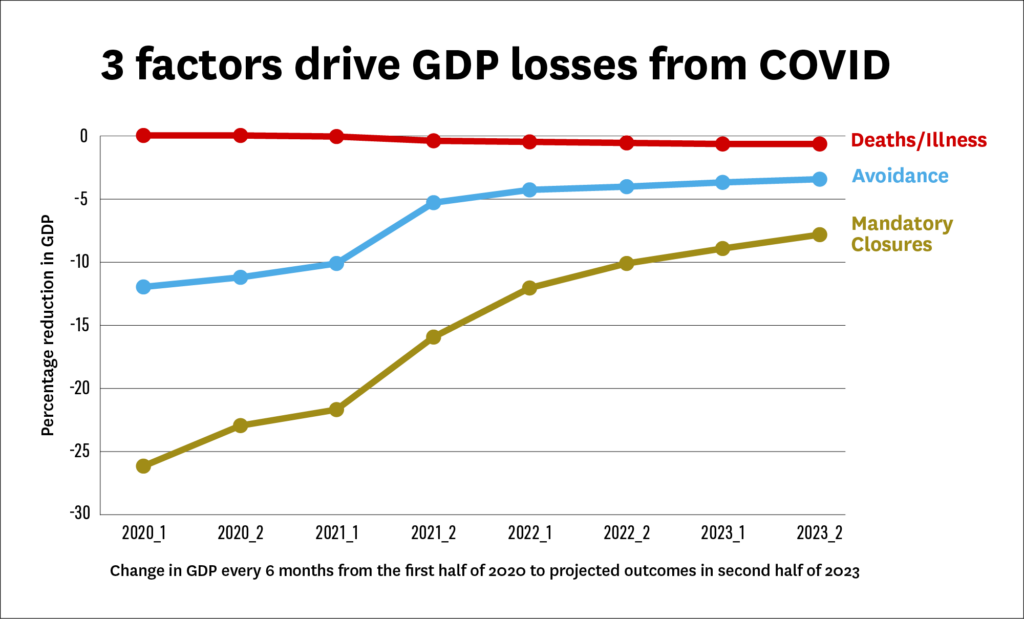Study highlights:
- $14 trillion loss in GDP over four years is projected as a result of COVID
- Stimulus spending had mixed results
- Interdisciplinary study used a disaster economics framework refined at USC
Involuntary business closures have been the leading cause of a massive decline in U.S. GDP during the COVID-19 pandemic, although personal voluntary behaviors to avoid infection also play a role, according to a new study by USC faculty.
The multidisciplinary study, which was published in Economic Modelling, estimates that the pandemic cut $12.2 trillion from U.S. GDP as of the end of 2022, with total losses expected to top $14 trillion by the end of this year – four years since the outbreak of the pandemic. The findings were based on a disaster economic analysis framework refined by one of the study’s authors.
“I’m still amazed at how powerful a negative impact COVID is projected to have on the U.S. economy compared to previous man-made and natural disasters. COVID’s impact on GDP is estimated to be nearly 100 times more than the previous largest disaster of the 21st century — the September 11, 2001, World Trade Center attacks,” said study co-author Adam Rose, a research professor at the USC Price School and a senior research fellow at the USC Center for Risk and Economic Analysis of Threats and Emergencies (CREATE).
Three factors drove economic losses during COVID-19
A trio of factors have driven the economic decline: deaths and illnesses; voluntary avoidance of activities that stimulate economic activity but which avoid infection; and mandatory business closures.
Business closures have had by far the greatest impact. During the first six months of the pandemic beginning in early 2020, for example, business closures accounted for a 26.3% decline in U.S. GDP, compared to a 12.2% decline through work avoidance.
Deaths and illnesses had the least effect because people who were no longer able to work were replaced by the large number of people who were unemployed by COVID.
According to the study, growth rose in late 2020 as businesses continued to reopen, but dipped again slightly in early 2021 with the re-introduction of some mandatory business closures and further voluntary avoidance in response to another wave.
Losses were partially offset by economic activity in health care, pent-up demand for goods and services and, in most but not all cases, government stimulus spending.
The CARES Act and three other rounds of stimulus enacted by Congress in 2020 helped alleviate some of the losses in economic growth due to the pandemic, study authors found. However, the American Rescue Plan, a $1.9 trillion stimulus package signed in early 2021, had the opposite effect by crowding out private investment, which occurs when rising public-sector spending drives down private-sector investment.
Additionally, deferred tax obligations enacted to stimulate the economy during the early stimulus rounds and coming due in 2022 and 2023 leave businesses with fewer funds for private investment.
Many people voluntarily changed behaviors to reduce COVID-19 risk
While news reports glommed onto stories about people who refused to wear masks or get vaccinated, study authors found many people voluntarily adopted behaviors to avoid getting sick. Avoidance behaviors included working from home, keeping children out of school, and steering clear of doctors, dining out, and certain forms of travel and leisure activities.
“A very surprising finding is the magnitude of voluntary avoidance behavior during the pandemic. We hear a lot about noncompliance with health guidelines and restrictions, but we found that many people voluntarily changed their behavior to reduce the chances of infection, even when there were no requirements to do so,” said Richard John, professor of psychology at the USC Dornsife College and associate director of CREATE.
But avoidance behavior came with a cost to business. During the height of the pandemic, international and domestic airline travel dropped by nearly 60%, indoor dining by 65% and in-store shopping by 43%.
The study was conducted using an Economic Consequence Analysis (ECA), which, unlike many standard macroeconomic analyses, identifies fundamental drivers of impacts on the economy. Although the technique has been around since the 1990s, Rose refined it to include exaggerated human responses that worsen economic losses and, conversely, people’s resilience in effectively recovering from a crisis and thereby reducing losses.
“Nearly all previous COVID-19 studies used macroeconometric or statistical models that are a top-down approach,” Rose said. “We used a bottom-up approach to identify fundamental causal factors, or drivers, of impacts.”
More about the study
The study, titled Macroeconomic consequences of the COVID-19 pandemic, was conducted by a multidisciplinary team of USC researchers from the USC Price School, USC Dornsife, the Leonard D. Schaeffer Center for Health Policy & Economics, and CREATE. In addition to Rose and John, study authors include Terrie Walmsley, Dan Wei, Jakub P. Hlávka, Juan Machado and Katie Byrd.
The study was funded by the U.S. Department of Homeland Security under Grant Award Number 17STQAC00001. The views and conclusions contained in the study are those of the authors and should not be interpreted as necessarily representing the official policies, either expressed or implied, of the U.S. Department of Homeland Security.

